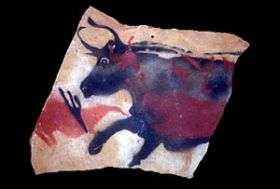Rare Minerals Illuminate 17,000-year old Questions

Scientists learned it straight from the bull's muzzle: cave painting shows evidence of ancient trade. In collaboration with French museums and research facilities, Stanford researchers have found evidence of scarce manganese oxide mineral exchange between prehistoric peoples of the French Pyrenees.
The results of their study, concerning the mineral composition of the 17,000-year old "Great Bull of Lascaux" lithograph in Dordogne, France, were published in the November 2006 edition of the 13th International Conference on X-Ray Absorption Fine Structure.
"This cave painting is among the world's oldest and most exquisite," said collaborator and Stanford Synchrotron Radiation Laboratory (SSRL) researcher and Faculty Chair Gordon Brown. "Archeologists have been concerned about the interpretation of this rock art and its pigments since it was discovered."
To minimize damage to the celebrated art, the researchers obtained microscopic black pigment samples collected by archeologists: one from the bull's ears and another from his muzzle. They then used an X-ray absorption method at SSRL Beamline 11-2 and at the European Synchrotron Radiation Facility to identify manganese oxide minerals in the samples. Absorption spectra revealed an "unanticipated" variety of manganese oxide minerals, including a rare occurrence of hausmannite (Mn3O4), never before encountered in prehistoric pigments.
Learning the mineral composition reveals its geographic origin, and may expose bits about the culture of early humans who made it. Finding hausmannite in the southwest region of Europe could mean that the area's manganese oxide source has been exhausted or forgotten—or, as the researchers propose, that prehistoric humans traded among each other, supplying the cave artists with ores imported from elsewhere in the region.
French scientists Francois Farges, Emily Chalmin, and others collaborated with Brown on this research.
Source: SLAC





















